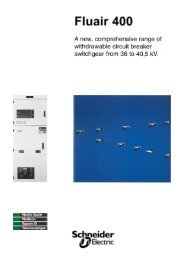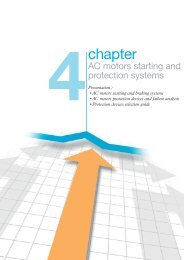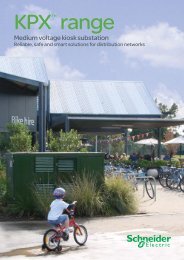Connect - Schneider Electric
Connect - Schneider Electric
Connect - Schneider Electric
Create successful ePaper yourself
Turn your PDF publications into a flip-book with our unique Google optimized e-Paper software.
Organisation<br />
At the corporate level, the Sustainable Development Department<br />
establishes the Group’s environmental strategy and leads the<br />
corporate environmental actors, jointly with the Global Supply Chain<br />
Management. The Director of Sustainable Development is ranked<br />
below the Executive Vice President of Strategy and Innovation<br />
(member of the Group’s Executive Committee).<br />
The Environment Director, ranked below the Senior Vice President<br />
of the Global Supply Chain Management (member of the Group’s<br />
Executive Committee), defi nes and rolls out the environmental<br />
policies and programs; he reports the results and leads the<br />
environmental manager network comprising:<br />
• for product management: environmental managers in each<br />
business who are responsible for integrating environmental<br />
concerns in line-up management, environmental representatives<br />
who are responsible for assessing the impact on marketing,<br />
and environmental specialists with expertise in integrating<br />
environmental aspects into product design;<br />
• for site management: environmental managers in each major<br />
region, environmental managers in each large region with<br />
signifi cant business volume, and environmental managers in<br />
each plant or supply chain centre.<br />
In 2010, the organisation within Global Supply Chain Management<br />
changed from a corporate only leadership to a regional organisation<br />
(North America, Asia-Pacifi c, Europe-Middle East, Africa and South<br />
America). Three SERE (Safety, Environment, Real Estate) directors<br />
were appointed: each one is responsible for implementing the<br />
Group’s policies in these fi elds for all sites within their geographical<br />
area and for reporting on progress plans. There is a meeting of the<br />
3.2 Reduction of CO2 Emissions<br />
Approach<br />
<strong>Schneider</strong> <strong>Electric</strong> is not subject to European quotas on carbon<br />
emissions since it is an industrial business that globally produces<br />
few emissions in comparison to energy intensive industries.<br />
<strong>Schneider</strong> <strong>Electric</strong> is therefore classifi ed in the low emissions sector<br />
by the Carbon Disclosure Project (1) . However, the Group has defi ned<br />
measures to reduce its carbon emissions.<br />
With the support of the Carbon 4 consultancy fi rm, <strong>Schneider</strong><br />
<strong>Electric</strong> in 2011 updated the carbon footprint performed in 2007<br />
(from 2006 data), from its upstream suppliers to its downstream<br />
distribution chain. The main sources of emissions remain the same:<br />
purchase of raw materials (steel, plastic, metal) and equipments<br />
represents around 70% of the total. The logistics involving<br />
upstream and downstream supply from and to suppliers and fi rst<br />
tier customers represents 15%, of which the main part comes from<br />
road freight. <strong>Schneider</strong> <strong>Electric</strong> is aiming to reduce these emissions<br />
by 10% over the next three years. Direct emissions (scope 1 and<br />
2) in Group buildings represent around 9%. More modest sources,<br />
employees’ travels and waste represent 5% and 1% respectively.<br />
This emissions split is representative of a second transformation<br />
activity.<br />
SUSTAINABLE DEVELOPMENT<br />
SCHNEIDER ELECTRIC’S COMMITMENT TO ENVIRONMENTAL PERFORMANCE<br />
three directors every quarter to ensure coherence in the Security,<br />
Environment and Real-Estate policies for the entire Group. To<br />
implement this policy, the SERE directors lead a network of more<br />
than 200 managers responsible for the environmental management<br />
of industrial, logistic, and administrative sites.<br />
These networks have access to a wide range of management<br />
and experience sharing resources including directives, application<br />
guides, an intranet site, and databases.<br />
The Transport Director, within Global Supply Chain Management,<br />
is in charge of measuring and reducing freight CO emissions at<br />
2<br />
Group level.<br />
Highlights of 2011<br />
• indexation of the performance incentives for the Executive<br />
Committee members to one of more components of the Planet<br />
& Society Barometer, chosen according to their fi eld: particularly<br />
Green Premium for Global Supply Chain Management and<br />
Activities, CO 2 reductions, ISO 14001 and Energy Effi ciency<br />
Monitoring for the Global Supply Chain Management;<br />
• a very steep rise in the Green Premium indicator, particularly<br />
as a result of the Environment Director rejoining the Executive<br />
Committee Management in charge of Global Supply Chain as<br />
well as because of the indexation of a portion of the performance<br />
incentives of the Activity directors of progress plans linked to<br />
Green Premium;<br />
• sustained reduction in CO 2 emissions due to the efforts to reduce<br />
the SF 6 leakage rate in industrial processes (0.94% leakage at<br />
the end of 2011).<br />
Compared to emissions evaluated in 2006, carbon intensity of the<br />
Group fell and certain sources were the subject of specifi c work in<br />
which the results are very visible: SF emissions for example were<br />
6<br />
signifi cantly reduced.<br />
Finally, the structure of emissions has changed: freight emissions as<br />
a percentage have decreased following a correction of the method<br />
used for 2006 fi gures.<br />
9%<br />
Site energy consumption<br />
(and SF 6 )<br />
15%<br />
Logistics transportation<br />
(from upstream<br />
to customer delivery)<br />
(1) Source: Carbon Disclosure Project 2008, Survey of the SBF120 French companies.<br />
1%<br />
Others<br />
(including waste)<br />
5%<br />
Employee travel<br />
(daily commute<br />
and business trips)<br />
70%<br />
Purchases of raw<br />
material and equipment<br />
REGISTRATION DOCUMENT 2011 SCHNEIDER ELECTRIC 61<br />
2

















